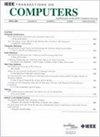A Novel Indirect Methodology Based on Execution Traces for Grading Functional Test Programs
IF 3.8
2区 计算机科学
Q2 COMPUTER SCIENCE, HARDWARE & ARCHITECTURE
引用次数: 0
Abstract
Developing functional test programs for hardware testing is time-consuming and experience-wise. A functional test program’s quality is usually assessed only through expensive fault simulation campaigns during early development. This paper presents indirect quality measurements of fault detection capabilities of functional test programs to reduce the total cost of fault simulation in the early development stages. We present a methodology that analyzes the instruction trace generated by running functional test programs on-chip and building its control and dataflow graph. We use the graph to identify potential flaws that affect the program’s fault detection capabilities. We present different graph-based techniques to measure the programs’ quality indirectly. By exploiting standard debugging formats, we individuate instructions in the source code that affect the graph-based measurements. We perform experiments on an automotive device manufactured by STMicroelectronics, running functional test programs of different natures. Our results show that our metric allows test engineers to develop better functional test programs without basing their development solely on fault simulation campaigns.一种基于执行轨迹的功能测试程序分级的间接方法
为硬件测试开发功能测试程序既耗时又需要经验。功能测试程序的质量通常只能通过早期开发中昂贵的故障模拟活动来评估。本文提出了功能测试程序的故障检测能力的间接质量测量,以减少早期开发阶段故障模拟的总成本。我们提出了一种分析芯片上运行功能测试程序所产生的指令轨迹并建立其控制和数据流图的方法。我们使用图来识别影响程序故障检测能力的潜在缺陷。我们提出了不同的基于图表的技术来间接衡量节目的质量。通过利用标准的调试格式,我们可以对源代码中影响基于图的测量的指令进行个性化处理。我们在意法半导体制造的汽车装置上进行实验,运行不同性质的功能测试程序。我们的结果表明,我们的度量允许测试工程师开发更好的功能测试程序,而不需要将他们的开发仅仅建立在故障模拟活动上。
本文章由计算机程序翻译,如有差异,请以英文原文为准。
求助全文
约1分钟内获得全文
求助全文
来源期刊

IEEE Transactions on Computers
工程技术-工程:电子与电气
CiteScore
6.60
自引率
5.40%
发文量
199
审稿时长
6.0 months
期刊介绍:
The IEEE Transactions on Computers is a monthly publication with a wide distribution to researchers, developers, technical managers, and educators in the computer field. It publishes papers on research in areas of current interest to the readers. These areas include, but are not limited to, the following: a) computer organizations and architectures; b) operating systems, software systems, and communication protocols; c) real-time systems and embedded systems; d) digital devices, computer components, and interconnection networks; e) specification, design, prototyping, and testing methods and tools; f) performance, fault tolerance, reliability, security, and testability; g) case studies and experimental and theoretical evaluations; and h) new and important applications and trends.
 求助内容:
求助内容: 应助结果提醒方式:
应助结果提醒方式:


